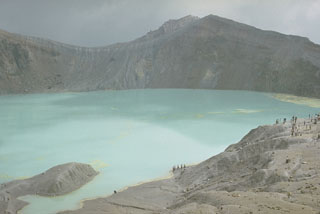Report on Kusatsu-Shiranesan (Japan) — September 1976
Natural Science Event Bulletin, vol. 1, no. 12 (September 1976)
Managing Editor: David Squires.
Kusatsu-Shiranesan (Japan) Three people killed by hydrogen sulfide
Please cite this report as:
Global Volcanism Program, 1976. Report on Kusatsu-Shiranesan (Japan) (Squires, D., ed.). Natural Science Event Bulletin, 1:12. Smithsonian Institution. https://doi.org/10.5479/si.GVP.NSEB197609-283120
Kusatsu-Shiranesan
Japan
36.618°N, 138.528°E; summit elev. 2165 m
All times are local (unless otherwise noted)
[On 3 August] a high school teacher and two students were overcome and killed by H2S, which is emitted in considerable quantities [from fumaroles on the NW side of Motoshirane-san, 2 km SSW of Yugama Crater]. The gas had concentrated in a bowl-shaped area during a light rain on a nearly windless day.
Further Reference. Ossaka, J., and others, 1980, Variation of chemical composition in volcanic gases and waters at Kusatsu-Shirane volcano and its activity in 1976: BV, v. 43.
Geological Summary. The Kusatsu-Shiranesan complex, located immediately north of Asama volcano, consists of a series of overlapping pyroclastic cones and three crater lakes. The andesitic-to-dacitic volcano was formed in three eruptive stages beginning in the early to mid-Pleistocene. The Pleistocene Oshi pyroclastic flow produced extensive welded tuffs and non-welded pumice that covers much of the E, S, and SW flanks. The latest eruptive stage began about 14,000 years ago. Historical eruptions have consisted of phreatic explosions from the acidic crater lakes or their margins. Fumaroles and hot springs that dot the flanks have strongly acidified many rivers draining from the volcano. The crater was the site of active sulfur mining for many years during the 19th and 20th centuries.
Information Contacts: JMA, Tokyo.

